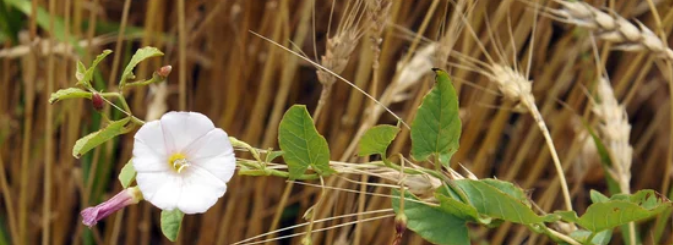At the root of almost every field bindweed outbreak is, in fact, the part of the plant that attaches to the soil and absorbs nutrients, said Kansas State University weed scientist Jeremie Kouame, noting that the weed becomes dominant within fields by developing a vast root system.
“It can stay in a soil’s seed bank for 50 years,” he said. “Initially, seeds that are near the soil surface germinate and start growing. As they grow, they rapidly produce a taproot that can stretch 30 feet deep in the soil.”
Kouame added: “After emergence, the plant will develop lateral roots that produce buds. Those buds then produce shoots, which create new plants. These daughter plants then multiply from the mother at a close distance.”
The root systems store carbohydrates that supply the weed with abundant energy, making it difficult to eliminate.
“The weed allocates a huge amount of carbohydrates to those roots. This energizes the above-ground and below-ground growth. In this way, the roots are what propagates the weed,” Kouame said.
Kouame suggests cleaning farm equipment and closely monitoring field borders to prevent the spread of field bindweed.
“Harvesting and tillage equipment should receive a thorough cleaning before moving from an infested area to a clean one to ensure vines are not transported,” he said. “Producers should also watch their field borders for the weed’s lateral roots, which grow fast and can invade neighboring fields.”
Field bindweed thrives with lots of sunlight. Producers can adjust crop planters to hinder the weed’s ability to receive this nutrient, Kouame said.
“Research shows that when there is a decrease in light intensity, the production of field bindweed seeds is reduced. Planting with narrow row spacing allows taller, more competitive crops to create an early canopy closure that suppresses the weed’s access to sunlight,” he said.
During dry years when moisture levels don’t allow for narrow-row planting, Kouame said herbicide treatments will also limit the presence of field bindweed.
“It takes multiple herbicide applications over multiple years because of the deep root system. Glyphosates and WSSA Group 4 herbicides (2,4-D, dicamba and picloram, for example) are the most commonly used,” he said.
Growers often sweep till areas – a shallow tillage strategy – to control field bindweed.
“It’s a common way of destroying the top growth of a weed by cutting the shoot from the roots 4-5 inches under the soil surface, which depletes the carbohydrates that are stored in the root system,” Kouame said.
The time of tillage and a field bindweed plant’s vigor both influence the efficacy of herbicide treatments, according to Kouame.
“Research has shown that when we delay tillage 3-7 days while using a glyphosate on field bindweed that has good vigor, excellent control is achieved,” he said. “When the vigor of the weed was fair, the maximum control was about 70% despite delaying tillage to 3-7 days.”
He added: “When field bindweed had poor vigor, a mixture of 2,4-D and picloram was required to achieve good control.”
A full-length discussion with Kouame on suppressing field bindweed is available on the weekly radio program, Agriculture Today, produced by K-State Research and Extension.



